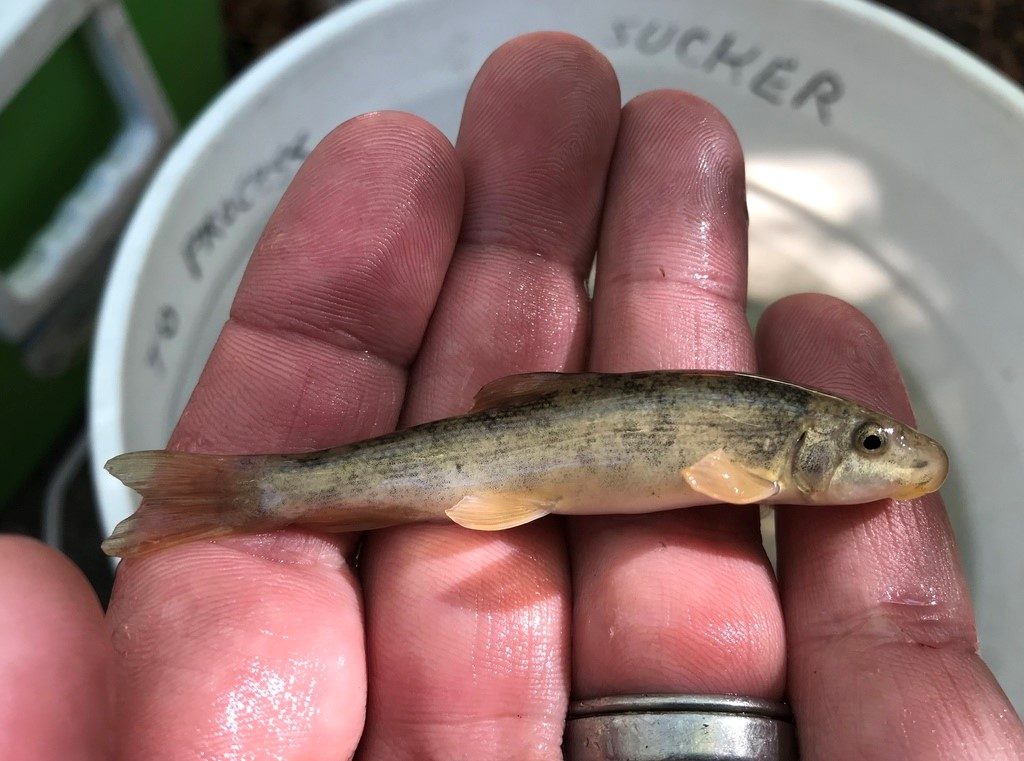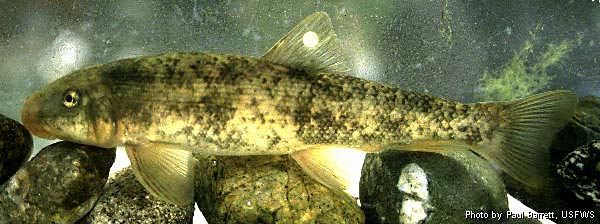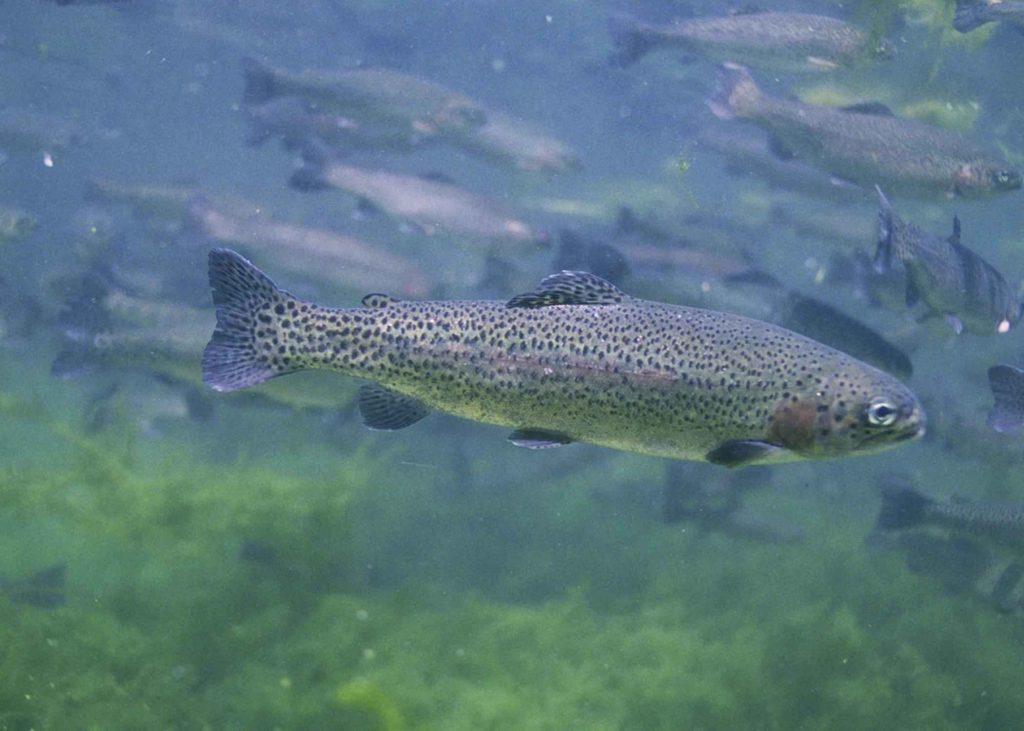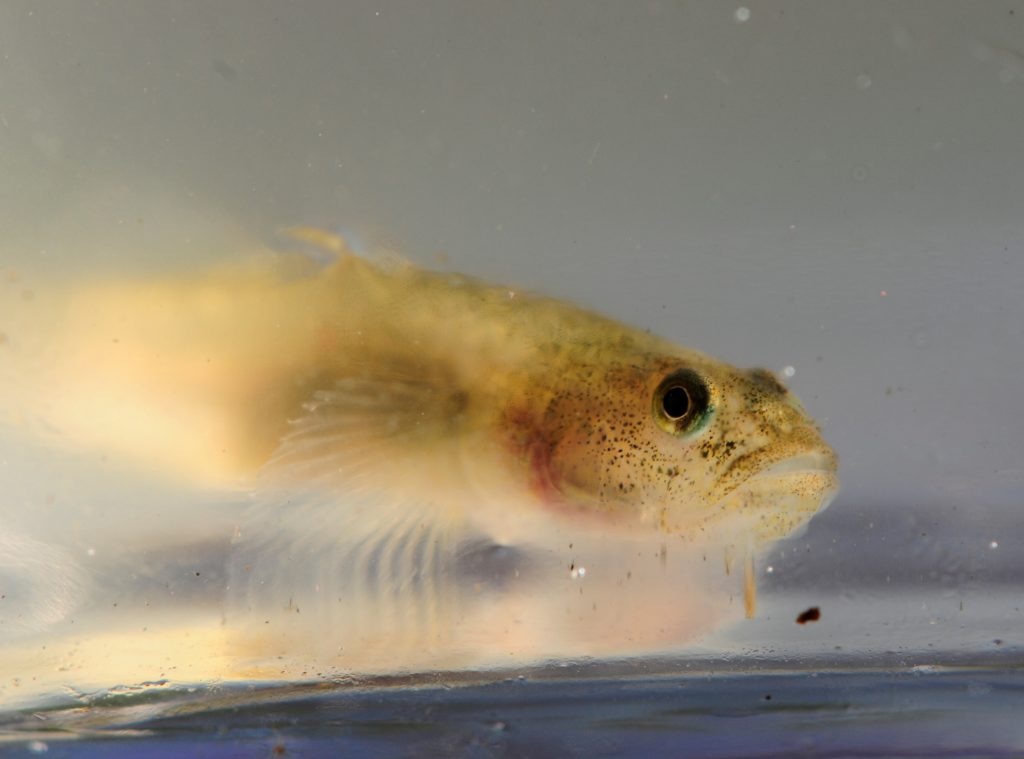To learn more about the fishes in the map above, select a species or scroll down.
- Santa Ana Sucker
Catostomus santaanae - Steelhead
Oncorhynchus mykiss - Tidewater Goby
Eucyclogobius newberryi
What is critical habitat?
Critical habitat refers to an area that is believed to be essential to the conservation of a federally endangered or threatened species. The designated area does not necessarily include the species entire range.
Learn more
Santa Ana Sucker, Catostomus santaanae

STATUS
Federal status: Threatened
POPULATION TREND
= Stable
RESTORATION
Intermediate
FAMILY
Catostomidae, a family of freshwater fish
RANGE
Los Angeles, San Gabriel, and Sana Ana River Basins
Appearance
A small (16 cm to 20 cm in length), freshwater fish with a silvery-white belly and dark gray sides and back. It is in the sucker family (Catostomidae) and can be identified by the downward orientation of its mouth, which is used to suck algae.
Habitat & Behavior
The Santa Ana sucker occurs in perennial streams where water ranges in depth from a few centimeters to several meters and currents are slight to swift. In Southern California, these streams are naturally subject to periodic flooding and drought conditions. They are most abundant in clear water of temperatures less than 72°F (22°C). The Santa Ana suckers do not occur above areas where the in-stream slope exceeds 7 degrees.
Threats
The primary threats to Santa Ana suckers are habitat loss, degradation, and modification. These changes in habitat can be attributed to dams, changes in water allocations, impacts related to recreation or wildfire, and potential effects of non-native vegetation (e.g. giant reed, Arundo donax) and predators such as non-native bass and sunfish, tilapia, carp, and catfish, and amphibians such as the American bullfrog.
Conservation
Riparian habitat for the Santa Ana sucker has been protected in Los Angeles in the Angeles National Forest and the recently established Angeles National Monument along Big Tujunga Creek and San Gabriel rivers. There has been an increase in critical habitat designations for the Santa Ana sucker and increased interest in removing dams that impact natural surface water flows of creeks and rivers.
Where can you spot it?
Big Tujunga Creek and upper San Gabriel River (North and East forks)

Back to threatened fishes list
Southern California steelhead, Oncorhynchus mykiss irideus

STATUS
Federal status: Endangered
POPULATION TREND
(-) Decreasing
RESTORATION
Difficult
FAMILY
Salmonidae, the salmon family
RANGE
The Southern California subspecies occurs from San Luis Obispo to the Mexican border
Appearance
Steelhead are silver-colored fish with black spots on their fins and a pink- or red-colored band that runs laterally along their body. They can be identified by their large, white mouths. In Latin, Oncorhynchus means “hook nose” (Onkos = hook, rynchos = nose), a feature that the male fish typically do not have.
Habitat & Behavior
The Southern California steelhead breeds from January to March in seasonally accessible, cool, clear rivers and streams. The fish need a continuous, rapidly flowing channel to complete their life cycle.
Threats
The current threats to the Southern California steelhead are habitat degradation, barriers to fish passages, water quality problems, drought, and non-native exotic fish and plants.
Conservation
A number of federal, state, and non-profit groups (e.g. CalTrout) work hard to maintain the current distribution of Southern California steelhead and restore areas previously occupied by the species. Dam management is a big part of restoring steelhead habitat. Attend Malibu City Council and Coastal Commission meetings, which are open to the public, to give local support to the removal of the Rindge Dam in Malibu.
Where can you spot it?
Southern California steelhead may inhabit a number of stream systems in the region, but can also be viewed at local aquariums.
Back to threatened fishes list
Tidewater goby, Eucyclogobius newberryi

STATUS
Federal status: Endangered
POPULATION TREND
(-) Decreasing
RESTORATION
Difficult
FAMILY
Oxudercidae
RANGE
Endemic to California
Appearance
The tidewater goby is a small (5 cm), sandy-colored fish with three transparent fins that run down its back. In proportion to its body, it has large eyes and a large mouth in a permanent “frown.”
Habitat
Tidewater gobies live in coastal lagoons, estuaries, and marshes, where they can survive in fresh and saline water (42 parts per thousand – ocean water is 35 parts per thousand by comparison) of temperatures ranging from 46 to 87 degrees Fahrenheit. These coastal wetland habitats are very dynamic; during different seasons, they may be connected to or isolated from the ocean. Floods from winter rains open waterways to the sea, and during the summer, sands accumulate and form dams that isolate pools from the ocean.
Tidewater goby prefers a sandy substrate for breeding, but throughout the year may also inhabit mud, silt, or rocky substrates where it can hunt for shrimp and amphibian and insect eggs. It is a bottom-dwelling fish that uses it front fins to prop up its head. Individual lifespans are approximately 1 year. Populations may include hundreds to thousands of gobies.
Threats
The tidewater goby occurs in 96 locations in California. Because their habitat is so dynamic, these metapopulations are isolated from each other. It is not uncommon for habitats to be unused for some time, or for populations to go locally extinct, then recolonize the sites. But development of lagoons and estuaries along the coast, including in Marina Del Rey and Long Beach, have been a major threat to tidewater goby habitats.
Conservation
In Los Angeles County, critical habitat has been designated in Malibu and Topanga creek. Malibu lagoon has also been restored to improve tidewater goby habitat.
Where can you spot it?
In Los Angeles, tidywater gobies can be found in the Malibu and Topanga lagoons, as well as exhibits at the Cabrillo Marine Aquarium in San Pedro.
Back to threatened fishes list
Data source:
Critical habitat from US Fish and Wildlife Service, accessed via ECOS (Environmental Conservation Online System)
References: